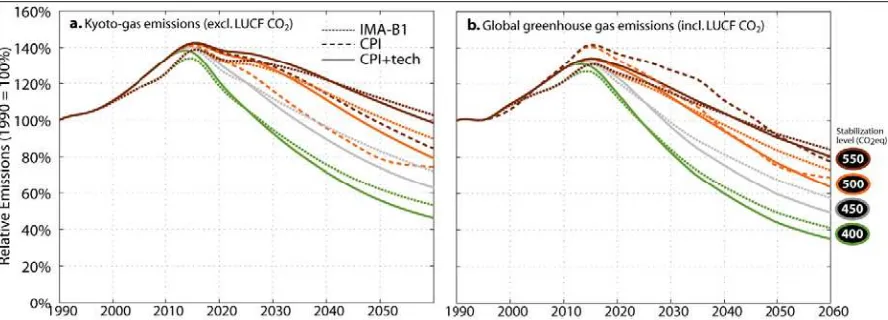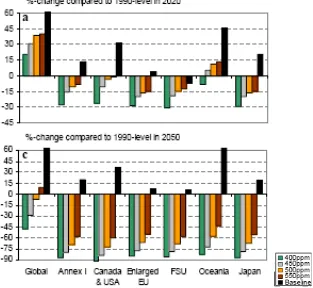Indicative
ranges
of
emission
reduction objectives for Annex I
countries
Submission of the Climate Action Network International to the AWG
June 2007
The Climate Action Network International (CAN) welcomes the opportunity to provide inputs to the AWG regarding indicative ranges of emissions reduction objectives by Annex I Parties. CAN is a coalition of more than 400 environmental and development non-governmental organizations in 85 countries worldwide, committed to limiting human-induced climate change to ecologically sustainable levels.
Introduction
The AWG’s analysis of the mitigation potential of policies, measures and technologies at the disposal of Annex I Parties will provide a useful bottom up analysis towards defining the sharing of absolute emissions reduction targets between Annex I countries. This analysis must be framed, however, in the context of global emission pathways that limit global average temperature increases as far below 2ºC as possible, in which Annex I Parties reduce emissions fast enough to allow an equitable share of emissions for Non Annex I Parties. Annex I Parties’ emission reduction obligations must be consistent with the ultimate objective of the Convention, that it, to prevent dangerous interference with the climate system.
In CAN’s view, it is essential that global average temperature increases must be kept as far below 2ºC as possible. A 2ºC increase risks placing hundreds of millions are risk of increased water scarcity (350-600 million Africans and 200-1000 million Asians), in low latitude tropical regions there is likely to be substantial increases in food security problems as agricultural productions suffers under higher temperatures, and there is a rapidly raising risk of major extinctions of plants and animals globally. Regions dependent on glacial fed water supply face either extinction of this resource, as for Latin American’s inter tropical glaciers, or major loss and disruption, as in central Asia.
Global Pathways
The Stern Report’s analysis, shown in Table 1, demonstrates that only the very lowest global stabilization levels provide any reasonable probability of being consistent with keeping well below 2ºC. Lower stabilization levels than those considered by Stern provide greater probabilities of avoiding dangerous climate change and it is such ambitious scenarios that should guide the work of the AWG, along with the recognition that developing countries need room within the allocation of the resources of such a carbon budget to develop their economies and to tackle poverty.
Probability of exceeding 2ºC (relative to preindustrial levels)
400 57% 33% 13% 8%
Table 1: Indicative range of likelihoods of exceeding a certain temperature change (at equilibrium), measures in CO2 equivalents1234. Red shading indicates a 60% chance of exceeding the temperature, amber 40% chance, yellow 10% chance and green less than 10%. Source; The Stern Review, 2006, p195
Although atmospheric equivalent concentrations5 of greenhouse gases are likely to cross 400pmm in the near term6, staying below 2ºC is still achievable if emissions peak soon enough and then are brought to lower levels fast enough7. This means that long term stabilization of GHG concentrations at or below 400ppm is still achievable if there is the political will to effect the necessary emissions reductions. Reducing the peak level of GHG concentrations to the lowest feasible level is critical to limiting warming to at or below 2ºC with any significant confidence and is indeed likely to be decisive as to whether the 2ºC objective can be reached at all8.
1Meinshausen, M. (2006): 'What does a 2°C target mean for greenhouse gas concentrations? A brief analysis based on multi-gas emission pathways and several climate sensitivity uncertainty estimates', pp.265 – 280 in Avoiding dangerous climate change, H.J. Schellnhuber et al. (eds.), Cambridge: Cambridge University Press. 2
Murphy, J.M., D.M.H. Sexton, D.N. Barnett, et al. (2004): 'Quantification of modelling uncertainties in a large ensemble of climate change simulations', Nature 430: 768–772
3Wigley, T.M.L. and S.C.B. Raper (2001): 'Interpretation of high projections for global-mean warming', Science 293: 451-454
4 IPCC (2001) “Third Assessment report” Cambridge University Press 5
Including the effects of aerosols.
6 IPCC WGIII Chapter 1: “Atmospheric CO2 concentrations… reaching 379 ppmv in 2005… The total CO 2 equivalent (CO2-eq) concentration of all long lived greenhouse gases is now about 455 ppmv CO2-eq, although the effect of aerosols, other air pollutants and land use change reduces the net effect to 311 to 435 ppmv CO2-eq” 7 Meinshausen, M (2006) “KyotoPlus –
Papers: <2ºC Trajectories– a Brief Background Note”, proceedings of the
conference ‘KyotoPlus: Escaping the Climate Trap’
8Den Elzen MGJ and M Meinshausen, (2005) “Meeting the EU 2ºC climate target: global and regional emission
Figure 1: Global emissions relative to 1990 excluding (a) and including (b) LUCF CO2 emission for the stabilization pathways at 550, 500, 450 and 400ppm CO2equivalent concentrations for three scenarios (CPI, CPI + tech and IMA-B1)9
For every scenario shown in Figure 1, global emissions will need to peak prior to 2020. The results presented in the IPCC WGIII’s Summary for Policymakers indicate that global CO2
emission must peak by 2015 for global temperatures to increase in the range 2-2.4ºC, see Table 2. This makes emission reductions in the second commitment period absolutely crucial to avoiding dangerous climate change. In this 400ppm scenario, emissions reductions of at least 50-60%, by 2050 are required, compared to 1990 levels. Maximum reduction rates of 2.5-3% per anum are required over the next 20 years. Any delay, in any of the scenarios, increases the emission reductions rates needed, and lowers the absolute emissions level after around 2050.
Radiative
Table 2: Characteristics of the more ambitious post- IPCC TAR stabilization scenarios10
Annex I: indicative ranges of emissions reduction required
The carbon budget of a global pathway consistent with the 2ºC target will need to be divided between countries in an equitable manner consistent with the Convention’s principles of ‘common but differentiated responsibilities and respective capabilities”. Furthermore, “the developed country Parties should take the lead in combating climate change”.
Figure 2: Change in Kyoto-gas emission allowances (excluding LUCF CO2emissions) before emissions trading from 1990 to 2020 (upper) and 2050 (lower) for the Annex I regions under a multistage approach for the stabilization pathways at 400, 450, 500 and 500ppm CO2- eq concentrations (red) for the CPI+tech scenario11
Work by den Elzen and Meinshausen, shown in Figure 2, demonstrates that under the 400ppm scenario, Annex I Parties would need reduce their emissions by approximately 30% by 2020 and around 85% by 2050 (both compared to a 1990 baseline). These cuts are attributed to Annex I countries in recognition of their historical responsibility, high per capita emissions and so that non-Annex I countries have sufficient emissions in this period to achieve development needs. Stabilizing at this level which would likely limit warming to 2ºC, in effect then requires a substantial decarbonization of Annex I economies by the middle of this century. If we are to have a higher chance of limiting warming to 2ºC or below, and if there is to be fair allocation of emissions to the Annex I countries, then virtually complete decarbonization of the Annex I countries would be needed by 2050 at the latest.
11Den Elzen MGJ and MMeinshausen, (2005) “Meeting the EU 2ºC climate target: global and regional emission
Annexes to this submission
Den Elzen MGJ and M Meinshausen, (2005) “Meeting the EU 2ºC climate target: global and regional emission implications” Netherlands Environment Agency, Report 728001031
Höhne, N, D Phylipsen and S Moltmann (2007) “Factors underpinning future action: 2007 update” Ecofys, Köln
Meinshausen, M (2006) “KyotoPlus– Papers: <2ºC Trajectories– a Brief Background Note”, proceedings of the conference ‘KyotoPlus: Escaping the Climate Trap’


